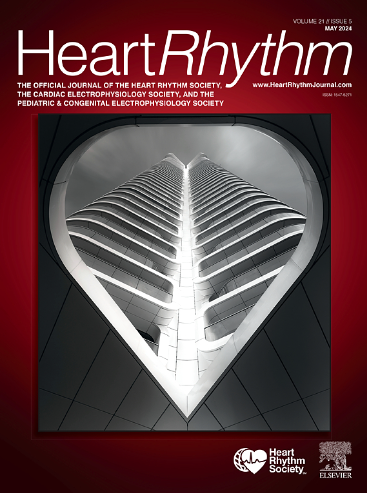高频低潮气量通气可改善持续性心房颤动消融的手术和长期临床结果:前瞻性多中心登记。
IF 5.6
2区 医学
Q1 CARDIAC & CARDIOVASCULAR SYSTEMS
引用次数: 0
摘要
背景:高频-低潮气量(HFLTV)通气可提高阵发性房颤(PAF)射频导管消融术(RFCA)的疗效和效率。这些益处能否推广到持续性房颤(PeAF)的射频消融中,目前尚无定论:评估与标准通气(SV)相比,在 PeAF 患者的 RFCA 过程中使用 HFLTV 通气是否能改善手术和临床效果:在这项前瞻性多中心登记(REAL-AF)中,纳入了使用 HFLTV 通气或 SV 进行 PVI+PWI 治疗 PeAF 的患者。主要疗效指标是 12 个月内无全房性心律失常。次要结果包括手术和长期临床结果以及并发症:共有 210 名患者纳入分析(HFLTV=95 对 SV=115)。两组患者的基线特征无差异。手术时间(80[63-103.5] vs.110 [85-141],pConclusion):在因 PeAF 而接受 RFCA 并进行 PVI+PWI 的患者中,与 SV 相比,使用 HFLTV 通气与 12 个月随访时较高的全房性心律失常发生率相关,且手术时间和 RF 时间显著缩短,同时安全性相似。本文章由计算机程序翻译,如有差异,请以英文原文为准。

High-frequency low-tidal volume ventilation improves procedural and long-term clinical outcomes in persistent atrial fibrillation ablation: Prospective multicenter registry
Background
High-frequency, low-tidal volume (HFLTV) ventilation increases the efficacy and efficiency of radiofrequency catheter ablation (RFCA) of paroxysmal atrial fibrillation. Whether those benefits can be extrapolated to RFCA of persistent atrial fibrillation (PeAF) is undetermined.
Objective
The purpose of this study was to evaluate whether using HFLTV ventilation during RFCA in patients with PeAF is associated with improved procedural and long-term clinical outcomes compared to standard ventilation (SV).
Methods
In this prospective multicenter registry (REAL-AF), patients who had undergone pulmonary vein isolation (PVI) + posterior wall isolation (PWI) for PeAF using either HFLTV ventilation or SV were included. The primary efficacy outcome was freedom from all-atrial arrhythmias at 12 months. Secondary outcomes included procedural and long-term clinical outcomes and complications.
Results
A total of 210 patients were included (HFLTV=95 vs. SV=115) in the analysis. There were no differences in baseline characteristics between the groups. Procedural time (80 [66–103.5] minutes vs 110 [85–141] minutes; P <.001), total radiofrequency (RF) time (18.73 [13.93–26.53] minutes vs 26.15 [20.30–35.25] minutes; P <.001), and pulmonary vein RF time (11.35 [8.78–16.69] minutes vs 18 [13.74–24.14] minutes; P <.001) were significantly shorter using HFLTV ventilation compared with SV. Freedom from all-atrial arrhythmias was significantly higher with HFLTV ventilation compared with SV (82.1% vs 68.7%; hazard ratio 0.41; 95% confidence interval [0.21–0.82]; P = .012), indicating a 43% relative risk reduction and a 13.4% absolute risk reduction in all-atrial arrhythmia recurrence. There was no difference in long-term procedure-related complications between the groups (HFLTV 1.1% vs SV 0%, P = .270).
Conclusion
In patients undergoing RFCA with PVI + PWI for PeAF, the use of HFLTV ventilation was associated with higher freedom from all-atrial arrhythmias at 12-month follow-up, with significantly shorter procedural and RF times compared to SV, while reporting a similar safety profile.
求助全文
通过发布文献求助,成功后即可免费获取论文全文。
去求助
来源期刊

Heart rhythm
医学-心血管系统
CiteScore
10.50
自引率
5.50%
发文量
1465
审稿时长
24 days
期刊介绍:
HeartRhythm, the official Journal of the Heart Rhythm Society and the Cardiac Electrophysiology Society, is a unique journal for fundamental discovery and clinical applicability.
HeartRhythm integrates the entire cardiac electrophysiology (EP) community from basic and clinical academic researchers, private practitioners, engineers, allied professionals, industry, and trainees, all of whom are vital and interdependent members of our EP community.
The Heart Rhythm Society is the international leader in science, education, and advocacy for cardiac arrhythmia professionals and patients, and the primary information resource on heart rhythm disorders. Its mission is to improve the care of patients by promoting research, education, and optimal health care policies and standards.
 求助内容:
求助内容: 应助结果提醒方式:
应助结果提醒方式:


